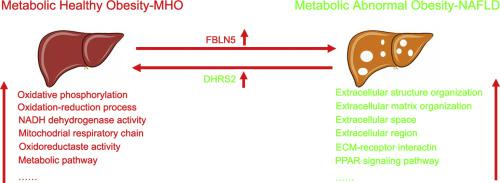当前位置:
X-MOL 学术
›
J. Proteomics
›
论文详情
Our official English website, www.x-mol.net, welcomes your feedback! (Note: you will need to create a separate account there.)
Proteomic analysis to identify differentially expressed proteins between subjects with metabolic healthy obesity and non-alcoholic fatty liver disease.
Journal of Proteomics ( IF 3.3 ) Pub Date : 2020-02-11 , DOI: 10.1016/j.jprot.2020.103683 Xianwen Yuan 1 , Yuanyuan Sun 2 , Qi Cheng 3 , Kai Hu 4 , Juan Ye 5 , Yinjuan Zhao 6 , Jing Wu 7 , Xiaoyan Shao 3 , Lei Fang 3 , Yitao Ding 1 , Xitai Sun 1 , Xiaolei Shi 1 , Bin Xue 7
Journal of Proteomics ( IF 3.3 ) Pub Date : 2020-02-11 , DOI: 10.1016/j.jprot.2020.103683 Xianwen Yuan 1 , Yuanyuan Sun 2 , Qi Cheng 3 , Kai Hu 4 , Juan Ye 5 , Yinjuan Zhao 6 , Jing Wu 7 , Xiaoyan Shao 3 , Lei Fang 3 , Yitao Ding 1 , Xitai Sun 1 , Xiaolei Shi 1 , Bin Xue 7
Affiliation

|
Obese subjects with non-alcoholic fatty liver disease (NAFLD) and considered metabolically healthy have not been well differentiated. In this study, obese subjects were divided into metabolic healthy obesity (MHO) and NAFLD groups. Liver tissues were sampled from these two types of subjects undergoing bariatric surgery, and proteins in the liver tissues that expressed differently between the two groups of subjects were identified by Tandem Mass Tags (TMT) assay. Compared with the MHO group, 132 proteins were found to be upregulated and 84 proteins were found to be downregulated (mainly localized in mitochondria) in NAFLD group. The KEGG pathway analysis showed that significantly upregulated metabolic pathways include PPAR signaling, ECM-receptor interaction and oxidative phosphorylation was significantly downregulated. The GO analysis revealed that upregulated proteins were involved in extracellular structure organization, extracellular matrix organization and downregulated proteins took part in the oxidation-reduction process and so on. FBLN5 and DHRS2 were further validated by Western blot, immunohistochemistry and ELISA. All results demonstrate that FBLN5 expression was significantly upregulated but DHRS2 was significantly downregulated. SIGNIFICANCE: The variation between MHO and NAFLD was studied by mass spectroscopy to evaluate the mechanism with which MHO subjects resist the harmful effects induced by obesity.
中文翻译:

蛋白质组学分析可识别患有代谢性健康肥胖和非酒精性脂肪肝的受试者之间差异表达的蛋白质。
患有非酒精性脂肪肝疾病(NAFLD)并被认为代谢健康的肥胖受试者尚未得到很好的区分。在这项研究中,肥胖受试者分为代谢性健康肥胖(MHO)和NAFLD组。从接受减肥手术的这两种类型的受试者中采集肝组织,并通过串联质谱标签(TMT)分析鉴定两组受试者之间表达差异的肝组织中的蛋白质。与MHO组相比,NAFLD组中有132个蛋白被上调,而84个蛋白被下调(主要位于线粒体中)。KEGG通路分析表明,代谢通路显着上调,包括PPAR信号传导,ECM-受体相互作用和氧化磷酸化显着下调。GO分析表明,上调的蛋白质参与细胞外结构的组织,细胞外基质的组织,而下调的蛋白质参与了氧化还原过程等。FBLN5和DHRS2通过蛋白质印迹,免疫组织化学和ELISA进一步验证。所有结果表明,FBLN5表达显着上调,而DHRS2被显着下调。意义:通过质谱研究了MHO和NAFLD之间的差异,以评估MHO受试者抵抗肥胖引起的有害作用的机制。免疫组织化学和ELISA。所有结果表明,FBLN5表达显着上调,而DHRS2被显着下调。意义:通过质谱研究了MHO和NAFLD之间的差异,以评估MHO受试者抵抗肥胖引起的有害作用的机制。免疫组织化学和ELISA。所有结果表明,FBLN5表达显着上调,而DHRS2被显着下调。意义:通过质谱研究了MHO和NAFLD之间的差异,以评估MHO受试者抵抗肥胖引起的有害作用的机制。
更新日期:2020-02-11
中文翻译:

蛋白质组学分析可识别患有代谢性健康肥胖和非酒精性脂肪肝的受试者之间差异表达的蛋白质。
患有非酒精性脂肪肝疾病(NAFLD)并被认为代谢健康的肥胖受试者尚未得到很好的区分。在这项研究中,肥胖受试者分为代谢性健康肥胖(MHO)和NAFLD组。从接受减肥手术的这两种类型的受试者中采集肝组织,并通过串联质谱标签(TMT)分析鉴定两组受试者之间表达差异的肝组织中的蛋白质。与MHO组相比,NAFLD组中有132个蛋白被上调,而84个蛋白被下调(主要位于线粒体中)。KEGG通路分析表明,代谢通路显着上调,包括PPAR信号传导,ECM-受体相互作用和氧化磷酸化显着下调。GO分析表明,上调的蛋白质参与细胞外结构的组织,细胞外基质的组织,而下调的蛋白质参与了氧化还原过程等。FBLN5和DHRS2通过蛋白质印迹,免疫组织化学和ELISA进一步验证。所有结果表明,FBLN5表达显着上调,而DHRS2被显着下调。意义:通过质谱研究了MHO和NAFLD之间的差异,以评估MHO受试者抵抗肥胖引起的有害作用的机制。免疫组织化学和ELISA。所有结果表明,FBLN5表达显着上调,而DHRS2被显着下调。意义:通过质谱研究了MHO和NAFLD之间的差异,以评估MHO受试者抵抗肥胖引起的有害作用的机制。免疫组织化学和ELISA。所有结果表明,FBLN5表达显着上调,而DHRS2被显着下调。意义:通过质谱研究了MHO和NAFLD之间的差异,以评估MHO受试者抵抗肥胖引起的有害作用的机制。


























 京公网安备 11010802027423号
京公网安备 11010802027423号